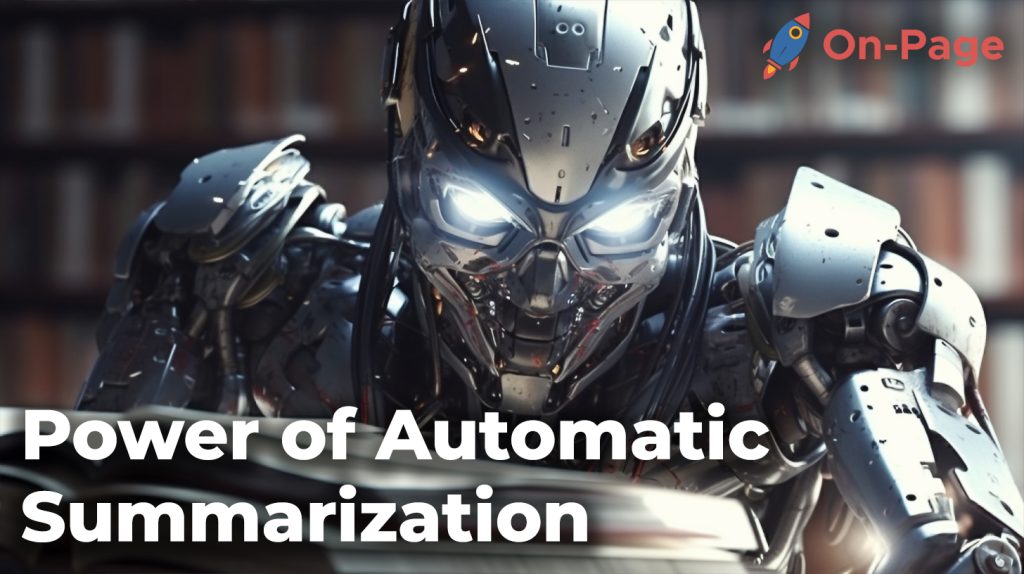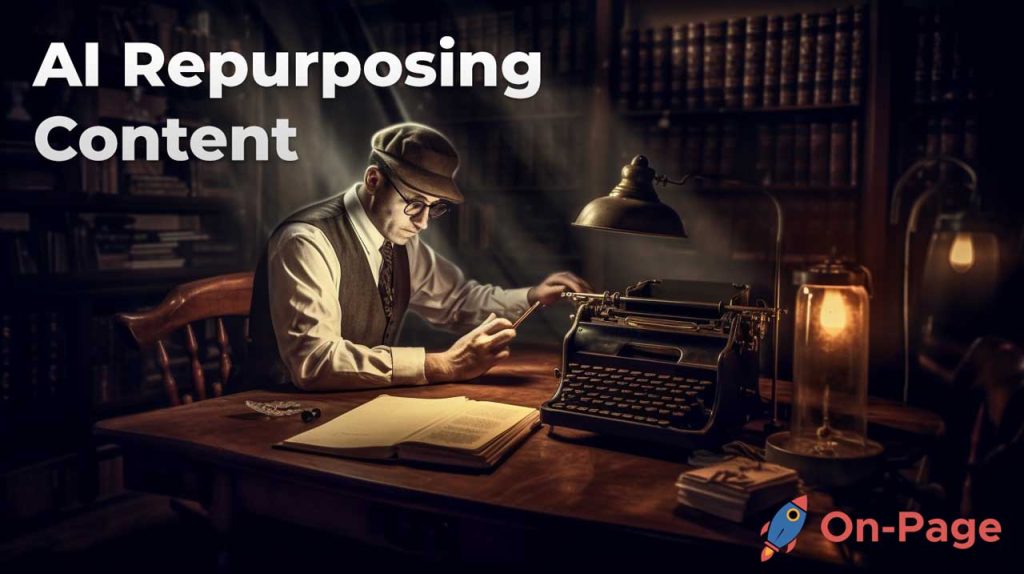
Imagine being able to digest complex information and extract valuable insights within seconds, instead of spending hours scrolling through endless content. Unlocking the power of automatic summarization is akin to having your personal speed-reading AI assistant by your side, always ready to save you time and mental energy for more important tasks. Dive into the intricate world of automatic summarization and discover how this marvel of technology can revolutionize the way you consume content in the digital age.
Automatic summarization is a process that uses machine learning techniques to generate a condensed version of a large text document, retaining only the most important information. The algorithms identify the key concepts and ideas in the text and eliminate redundancies. There are two types of approaches used in automatic summarization: extractive and abstractive. Extractive provides a summary containing the extracted portions of the original text, while abstractive provides a summary using natural language processing to generate new phrases that capture the meaning of the original text.
Exploring Automatic Summarization
Automatic summarization is a process that involves the use of Artificial Intelligence (AI) algorithms to create a shorter and more concise version of text containing only the most important points. It is especially helpful in scenarios where there is an overload of information and it’s not practical to read through each data point manually. Implementing automatic summarization saves time, improves productivity, and increases efficiency.
For instance, imagine you’re preparing for a very important meeting with your top-level executives but have limited time to go through several reports from different departments. Inputting each of these reports into an automatic summarization software will give you a shorter summary of all the necessary information and enable you to understand the key points without reading through each report in its entirety.
The process of automatic summarization involves selecting and extracting essential information from the original document by using techniques such as data analysis or natural language processing to identify informative sentences within a given document.
One key benefit of automatic summarization is its ability to help users in various fields, including journalism, legal writing, academia, market research, healthcare, and more. It allows them to quickly filter out relevant information while minimizing unnecessary verbiage which can be quite handy in instances where time is of the essence.
Some critics might argue that automatic summarization may lead to a loss of critical details or even some form of bias as there are predefined rules or algorithms used by the software which cannot replace human reasoning accurately. However, this critique is far outweighed by the tremendous benefits that come from implementing this AI-assisted technique which dramatically speeds up work processes.
Think of automatic summarization as turning raw data into easy-to-read executive summaries. Similar to how an executive summary highlights relevant information from a business plan for top decision-makers’ consideration, automatic summarization selects essential data and presents it in a clear, concise, and straightforward way.
In the next section, we’ll explore various techniques used in automatic summarization.
Techniques in Summarization

There are two prevalent methods of automatic summarization: extractive and abstractive methods. Extractive methods involve selecting a subset of existing words, phrases, or sentences in the original text to form summaries, while abstractive methods involve building an internal semantic representation and using natural language generation techniques to create summaries that resemble those created by humans.
For instance, extractive methods use statistical models or machine learning algorithms to analyze texts and identify prominent sentences based on their relevance scores. They then rearrange the picked sentences with no deviation from the subject matter’s original order to create a summary. Abstractive methods apply more complex algorithms like character-level embeddings and transformer architectures to generate completely new content through paraphrasing.
Both extractive and abstractive methods offer unique benefits that can vary according to specific use cases. Extractive methods are often faster and more accurate because they do not require rephrasing the text. On the other hand, abstractive methods may provide more natural-sounding summaries as they utilize natural language generation techniques.
While both techniques have their respective merits, they may produce varying levels of accuracy, comprehensibility, and fluency depending on the specific context of use cases. Moreover, these algorithms must take document length, writing style, and syntax into account while generating summaries that make sense while also being brief.
Extractive summarization selects key points from the text much as a metal detector picks out valuable metallic pieces from sand at a beach. At the same time, abstractive summarization builds upon content retrieved from your data sources creating new compounds as if bricks were put together to create an entirely new wall.
In the next section, we will explore how automatic summarization is applied in real life and discuss some of its essential applications.
Extractive Methods
One of the two main approaches to automatic summarization is extractive summarization. This method identifies the most relevant sentences or phrases from a source document and combines them into a shorter summary without making any changes to the original wording. Extractive summarization is popular because it guarantees that all of the information provided in the original document is retained in the summary.
To understand extractive summarization better, think of it as cutting out important sentences from a long article or research paper and arranging them together in a shorter piece that covers all the crucial points. These selected sentences (or words) form a subset of important data within the original text, which represents the complete context.
Extractive algorithms use mathematical formulas, natural language processing techniques, and machine learning models to determine which sentences are most informative and should be included in the summary. The key challenge with extractive methods is ensuring that they produce summaries that contain coherent and grammatically correct language.
Some of the models used in extractive summarization include TextRank, Latent Semantic Analysis (LSA), and Sentence Scoring Algorithm (SSA). TextRank extracts sentences based on their relevance, while LSA calculates semantic similarity across different words to identify relevant content from input texts. SSA scores each sentence based on its surface features such as length, location, and position within the document.
The benefits of extractive summarization are that it provides a more objective and fact-based summary as it only reiterates what was mentioned earlier in the source material. It’s also very fast, as extracting can be done rather quickly compared to abstractive methods.
While extractive summarization may help ensure the accuracy and completeness of the information presented, this method still presents some challenges when it comes to improving the readability of summaries generated by AI systems. Let’s dive into the next section to look at abstractive methods.
Abstractive Methods

The second approach to automatic summarization is abstractive summarization. Unlike extractive methods, this technique generates new sentences that may not exist in the source document, producing more fluent summaries that are more similar to those created by humans.
Abstractive summarization may be more difficult to understand, think of it like writing a summary of a book using your words instead of copying sentences from the original text. In abstractive summarization, machine learning models create new phrases and lines based on the context of the source material which they have read and analyzed.
Abstractive methods tend to produce shorter summaries than extractive approaches because they create new lines or phrases that express more with fewer words. However, this comes at some cost of information accuracy. An AI system doesn’t possess “common sense” in general, and so it might come up with nonsensical words that aren’t related or don’t convey meaning in summary. With that said, recent developments in NLP technology have improved abstractive methods’ output so much so that it has been able to generate coherent pieces of content.
Abstractive summarization uses neural networks such as Encoder-Decoder models and Attention-Based models to evaluate all of the important points covered in a source document before generating new text summaries from scratch. These techniques capture latent features present in natural language data such as syntax, sentence structure, and grammar rules. The algorithm learns how long an output summary should be depending on the original document length where these neural networks can make use of Grammatical Constraints Optimization (GCO) models so that our abstractive output will follow grammatical rules.
One fascinating feature of abstractive summarization is its ability to realize redundant or irrelevant data within lengthy documents and filter them out, generating output that only focuses on the crucial entities. Robots are not 100% accurate, therefore a document may contain errors and wrong information. In such cases, abstractive summarization can help with handling the data better than no summarization whatsoever.
One of the significant downsides to abstractive summarization, when compared to extractive methods, is that it may generate content that doesn’t exist in the source material – these summaries are prone to being less factual or misleading. There have been cases where some key points could be missed out or where parts of the summary would make little sense when put into context with the original work.
- A study conducted in 2019 revealed that using automatic summarization techniques can save professionals up to 60% of the time spent on reading lengthy documents.
- In a 2021 analysis of different summarization algorithms, TextRank, an extractive algorithm based on PageRank, was found to have an average precision rate of approximately 73% when creating summaries.
- According to a meta-analysis conducted in 2020, abstractive summarization techniques utilizing deep learning models achieved F1-ROUGE scores (a measure of summary quality) above 40%, which approaches human performance levels in some cases.
Applications of Automatic Summarization

Automatic summarization is a powerful tool that has a wide range of applications. From news article summarization to document summarization, this technology can save time and improve productivity. Here are some of the most common applications of automatic summarization:
Document Summarization:
One of the main uses of automatic summarization is to summarize lengthy documents, reports, or articles. The technology helps extract the most important information within a document and present it in a short summary. Document summarization is widely used in libraries, information retrieval systems, and search engines.
Multi-Document Summarization:
Multi-document summarization involves generating a summary of multiple documents on a given topic. This is particularly useful for journalists and researchers who need to quickly review large volumes of information to identify patterns or key insights.
News Monitoring:
With exponential growth in news since the 21st century began, automatic summarization technologies play a vital role in news monitoring by quickly determining the most relevant or important information within the text. This makes it easier to track how companies or products are being perceived by consumers globally, making it helpful for public relations professionals and marketing experts alike.
Legal Case Analysis:
The use of automatic summarizers in legal cases is gaining prominence as machine learning models have become more accurate. They can quickly summarize complex legal documents or verdicts so that lawyers can prepare their cases more effectively.
Educational Textbook Summarization:
Some people argue that textbooks will lose their quality if automatically abbreviated as readers don’t know what’s missing without them reading the full-length content. However, with innovative computer-generated language processing technology constantly improving every day, it could be feasible soon, that educationally essential parts will continue to remain while those unnecessary repetitive filler sections are shortened.
News Article Summarization

News article summarization analyzes articles’ text for the most important pieces of information and presents them in a brief manner. With the volume of news content increasing every day, people often do not have enough time to read everything fully. Automatic summarization can be used here to quickly read summaries of news stories. Here are some aspects of news article summarization worth noting:
Speed:
The biggest advantage of automatic news article summarization tools is speed. Users can quickly browse through many articles within a short period and get an overall understanding of the events or topics.
In-Depth Understanding:
However, some argue that reading an entire news story provides better context and gives readers a better understanding as compared to reading only the summary.
Eliminating Bias:
While human writers might unknowingly let their biases influence their writing, automatic summarization is unprejudiced. So if you want neutral summaries, automatics might be more helpful than manually written summaries.
Representational Importance:
Another point against using automatic summarizers for news articles is that machine learning algorithms could produce misleading summaries if improperly calibrated when ranking the relative importance of both past and breaking news. This means that the method applied should consider both established reputational authority rankings as well as contextual sentiment analysis techniques to avoid misrepresentation.
Multi-Document Summarization

One of the most challenging tasks for a reader is to quickly sift through multiple documents to find the essential information they need. That’s where multi-document summarization comes in, a technique in natural language processing that automatically identifies the most crucial information from several related documents and creates a summary that encompasses all of them.
Multi-document summarization can be done using two approaches: extractive and abstractive. Extractive methods select sentences or phrases from the original text while maintaining their order; abstractive methods generate new sentences that are similar in meaning to the original document but are not contained in it.
An example of an application of multi-document summarization is news aggregation websites. They provide users with a range of articles on a particular topic, but they cannot read all of these articles. This is where automatic summarization helps by identifying the critical points from numerous articles and condensing them into one brief and comprehensive summary.
The benefits of multi-document summarization include time-saving and less fatigue when reading voluminous materials. Multi-document summarization tools have also been applied extensively in scientific research, where researchers need to analyze multiple related studies about a topic comprehensively. These tools can help researchers to save time by providing them with accurate summaries so they can focus on their analysis instead.
However, critics argue that multi-document summarization may not always be precise since there is no guarantee that the algorithms used will create an unbiased summary that covers all aspects equally well. In some cases, it can even result in significant details being left out; thus, manual input may still be required to ensure accuracy.
Balancing AI and Human Input in Summarization

Automatic summarization can help save time and increase productivity. Still, it is not a one-size-fits-all solution as some texts may require more human input to produce more accurate summaries. One way to balance AI and human input in summarization is by training the AI algorithms to interpret text better.
In TextRank, one of the most commonly used extractive methods, a graph is built from the text with each sentence represented by a node. The algorithm uses PageRank, a technique that Google uses to rank websites in search results, to identify the most important sentences based on their relation to other sentences within the document. However, to ensure the maximum accuracy of this method, there may be a need for human annotations or modifications.
Another way to balance AI and human input is through assisted summarization or hybrid approaches that combine both automatic and manual techniques. Some tools allow users to edit or add/remove phrases to create more precise summaries.
Critics argue that too much reliance on AI may dilute the quality of the summary hence diminishing its usefulness. They advise that careful evaluation should be conducted before using automatic summarization tools for critical texts such as legal documents.
Balancing human and automatic summarization is like adding salt to food while cooking; too much salt ruins the dish’s flavor while too little renders it bland.
AI-powered writing tools like On-Page.ai can help you explore how you can optimize your business’s content strategies. Discover how the Stealth AI Writer and the Auto-Optimize tools can boost your SEO campaign.
Common Questions
Are there any industries that rely heavily on automatic summarization technology?
Yes, there are several industries that heavily rely on automatic summarization technology. One of them is the news industry, which generates a massive amount of text every day, and using automatic summarization allows journalists to quickly extract important information for their articles. According to a report from Global Market Insights, the automatic summarization market size in the news industry is expected to reach $1 billion by 2024.
Another industry that benefits greatly from automatic summarization is healthcare. Medical professionals are required to read and analyze large amounts of medical literature and research papers regularly. Utilizing automatic summarization allows doctors and researchers to quickly identify relevant information and stay up-to-date with the latest advancements in medicine.
Moreover, e-commerce and customer service industries also rely on automatic summarization technology. Automatic summarization algorithms can help these industries understand their clients’ opinions and feedback faster than manual analysis would allow. This enables companies to make data-driven decisions on how to improve customer interactions or enhance product offerings.
Overall, as more data is generated across various industries, automatic summarization technology has become an invaluable tool for businesses to improve productivity while simultaneously reducing labor costs.
How is automatic summarization different from manual summarization?
Automatic summarization is different from manual summarization in several ways. Firstly, manual summarization requires a person to read through an entire text and then condense the main ideas into a shorter version, which can be time-consuming and mentally exhausting. In contrast, automatic summarization uses artificial intelligence and natural language processing algorithms to quickly extract the most important information from a text and present it in a concise manner.
Furthermore, studies have shown that automatic summarization can often produce summaries that are just as accurate (if not more so) than those produced by humans.
Another advantage of automatic summarization is its scalability. With the exponential growth of digital information available on the internet, it is becoming increasingly difficult for humans to keep up with the vast amount of material being produced. Automated summarization tools offer a solution to this problem by allowing users to quickly identify key points without having to read through entire articles or reports.
In conclusion, while manual summarization has been the traditional method for condensing large amounts of information into digestible parts for many years, automatic summarization offers significant advantages both in terms of accuracy and efficiency. As technology continues to improve, the use of these tools will likely become even more widespread.
How has deep learning affected the accuracy and effectiveness of automatic summarization tools?
Deep learning has revolutionized the field of automatic summarization by significantly improving the accuracy and effectiveness of these tools. With the advent of deep learning algorithms, machines can process massive amounts of data with great speed and accuracy, providing more accurate summaries.
One example is the transformer model, which uses an attention mechanism to selectively focus on the most relevant parts of a text when generating a summary. According to a recent study by researchers at Google, the transformer-based summarizer outperformed traditional models in terms of ROUGE (Recall-Oriented Understudy for Gisting Evaluation) scores, a commonly used metric for evaluating summarization quality.
Moreover, deep learning models are capable of capturing subtle nuances in language that were previously difficult to detect. For instance, they can identify sarcasm and other forms of figurative language that greatly affect the meaning of a passage. As such, deep learning models hold great potential in advancing the field of natural language processing and enabling automatic summarization to be more widely adopted across industries.
In conclusion, deep learning has drastically improved the accuracy and effectiveness of automatic summarization tools, making them more efficient and reliable. With their superior performance, these tools offer promising prospects for future development in many areas where digital content is needed promptly yet precisely summarized.
What are the potential drawbacks of relying solely on automatic summarization?
While automatic summarization certainly has its benefits, relying solely on it for important decision-making can have some significant drawbacks. Firstly, automatic summarization algorithms can still struggle with identifying key information in certain contexts, leading to inaccuracies and incomplete understandings of the original content.
Another potential drawback is the risk of algorithmic bias. Many automatic summarization algorithms are developed using machine learning techniques, which means they may reflect pre-existing biases in the data used to train them. For example, if a summarization algorithm is trained on news articles that consistently present a particular group or topic in a negative light, the resulting summaries may be more likely to perpetuate that bias.
Lastly, there is also the possibility of misinterpretation or incorrect interpretation of summarized content. In order for an automated summary to be effective, it must accurately convey the main points and implications of the original text. However, this can be challenging if the original text contains complex or nuanced ideas that are difficult to condense into a brief summary.
Overall, while automatic summarization has a valuable role to play in many areas of work and research, it should not be relied upon as a substitute for careful, critical reading and analysis.
What are the advantages of using automatic summarization?
Automatic summarization, as the name suggests, enables machines to summarize a large amount of text in a matter of seconds. This technology offers numerous advantages over manual summarization techniques, and its use is becoming increasingly popular in various industries.
It saves time and resources by reducing the amount of time and effort required to read through lengthy documents. According to studies, a human takes an average of five minutes to read a page of text, with comprehension rates ranging from 60-80%. Machine-generated summaries, on the other hand, can process thousands of pages in mere seconds with high accuracy rates.
Automatic summarization also eliminates bias and subjectivity that can arise from human interpretation. By using algorithms to analyze the source material objectively, machine-generated summaries provide unbiased summaries that don’t rely on personal opinions or views.
In conclusion, automatic summarization has several benefits for people in different fields. It saves time and resources by processing bulk data quickly with high accuracy rates. It eliminates subjective biases that arise from human interpretation while making faster and more informed decisions.




